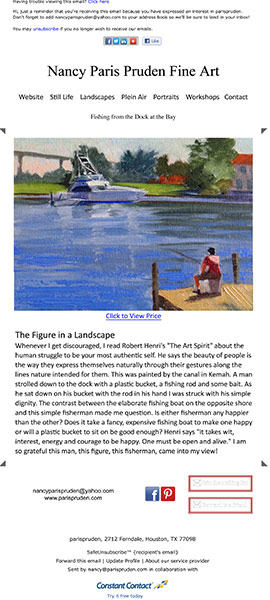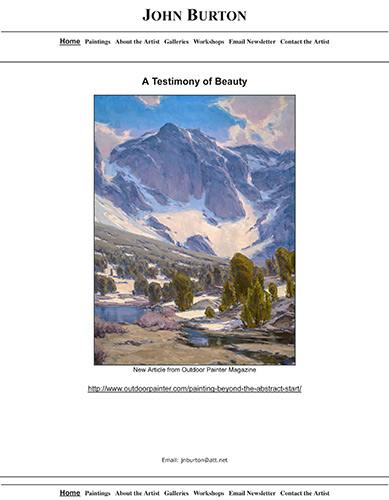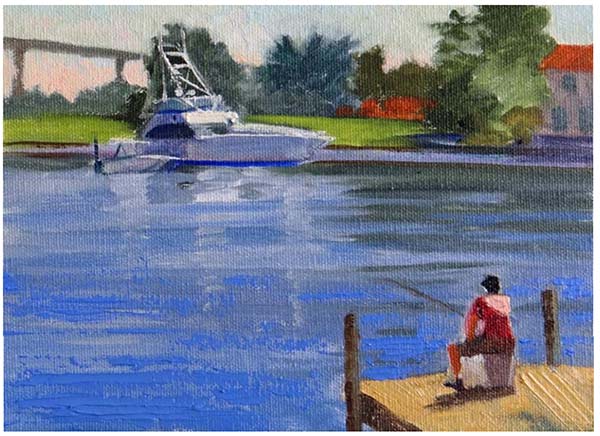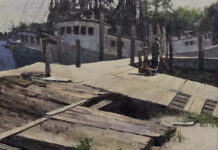– Bob Bahr reporting, Editor PleinAir Today –
Dave Geada has examined hundreds of artist websites as part of his job as master of marketing and strategy for Fine Art Studio Online (FASO), the biggest host of individual websites for painters. His training and his observations of painters who successfully market and sell their work put him in the perfect position to offer advice on using the Internet. Here are seven strong suggestions from Geada.
Lead Image: Nancy Paris Pruden regularly sends out attractive newsletters with headlines and images that engage the reader.


Of course, Geada recommends using FASO for web hosting and for newsletter creation and distribution. But there are some guidelines that apply no matter how an artist approaches Internet sales and marketing.
- Focus on improving as an artist first.
Work on your craft and get better before investing too much time and money in marketing and an online presence. “Get feedback on your progress by seeking out mentors, going to workshops, and entering juried contests,” Geada recommends. “And when the feedback becomes increasingly positive, that’s when you can begin to double down on marketing, and things begin to really take off. If you follow this pattern, you cannot help but be successful. And that’s when an artist website can really come in handy.”
- Use the Internet to keep in touch with prospective buyers.
Be realistic about how much and in what ways the Internet can help you. “Very few collectors buy art without seeing it in person,” Geada points out. “And the collectors that buy art in this way are typically returning collectors who have bought one or more pieces from that artist in the past and were happy with it. So there’s a trust that has been established that gets them over the hump of buying online. It is fair to say, however, that the Internet influences people to buy in almost all cases. They may only buy after seeing the art in person first, but the path that got them to your gallery showing, or your booth at the art festival or your studio, was laid down with dozens of online interactions. Without those interactions, they would never have showed up in person to buy your art.”
- Build an artist website, and make it the center of everything you do online.
Along with your artwork, make sure that you include details about yourself. Remember, people don’t just buy your art, they buy the story behind your art. So tell that story. Building a website can be complicated and can take away from time in the studio. So it’s important that you choose a website provider that makes creating and maintaining your website as easy as possible.
- Launch an e-mail newsletter.
E-mail newsletters are one of the best ways to keep in touch with collectors until they are ready to buy. Consistency matters most in newsletters. “You can have great content, but if you don’t send your e-mails out regularly, you’re going to be much less successful with it,” Geada says. He recommends sending something out once a week, thinks once a month is good, and says only those who are tightest in terms of time should scale back to sending a newsletter out quarterly (four times a year).
Consider handing over distribution of your newsletter to an outside company. “There are plenty of sources online that help prevent professional e-mail marketers from running afoul of spam filters,” Geada says. “The problem is that they are very technical in orientation, and frankly, every minute you spend researching this stuff is a minute you lose in the studio. So what I recommend to artists is that they pick a newsletter platform that handles all this opt-out and spam stuff for you behind the scenes.”
- Get active on social media.
Social media is a great complement to e-mail newsletters when it comes to keeping in touch with collectors. Like newsletters, consistency is key. But social media’s immediacy and shorter format enable artists to quickly post short updates once a day.
- Get permission before you market to collectors.
Never market to someone online without getting his or her permission first. “There’s nothing more annoying than getting unsolicited e-mails from an artist that you never wanted to hear from in the first place,” says Geada. “Ask permission first, and that will make your communication welcome and effective.”
- Get your fears about image piracy into perspective.
It happens, but compared to the benefits of posting images online, it is an acceptable risk. “You can’t let fear rule you,” Geada says. “It would be hard for an artist to promote themselves and put nothing online ever. I think it’s better to focus on promoting yourself, to use regular web-resolution images online, maybe add an attribution or very tasteful watermark to the images, and move on.”
FASO can be reached here.




